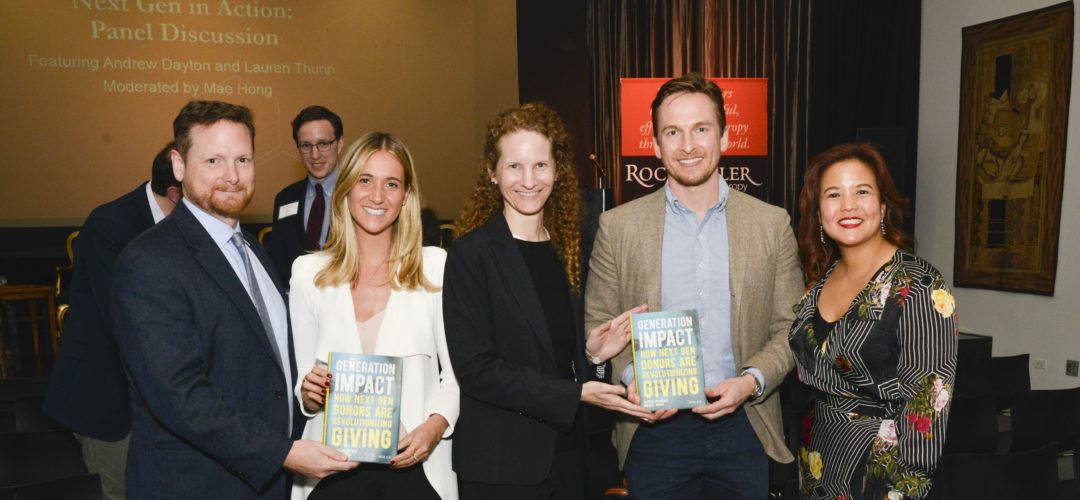Next Gen Donors and the New “Golden Age” of Philanthropy
May 02, 2018
In April, Rockefeller Philanthropy Advisors hosted an event at the Arts Club of Chicago, titled New Tools, New Rules: How Next Gen Donors are Shaking Up Philanthropy. With approximately 40 guests representing both traditional and next gen philanthropy, the discussion explored how donors under 40 are taking innovative and passionate approaches to incorporating philanthropy into their careers and life.
One of the number one topics that comes up in meetings with philanthropic families and foundations, according to Rockefeller Philanthropy Advisors Vice President Mae Hong, is how to engage next gen donors. To address that question, special guests Sharna Goldseker and Michael Moody, authors of Generation Impact: How Next Gen Donors are Revolutionizing Giving helped provide a picture of next gen donors’ giving styles and priorities based on research and extensive interviews.
Goldseker, herself a next gen donor as well as the Executive Director of the philanthropic organization 21/64, was drawn to this research from the start. “This topic is a labor of love and a passion of mine,” she said when discussing what caused her to start this project, speaking from the perspective of both a philanthropic professional as well as a member of a philanthropic family. “I’ve worked with so many families over the years who say that engaging the next generation is a goal… We feel like the next generation are the most significant donors in history, who can have the most impact.”
How are the next gen different from their predecessors? It seems like the answer may lie in one word repeatedly emphasized by the speakers: impact. “The number one thing we’ve heard from the next gen when we talk about what they want to achieve is impact,” Moody explained. “They want to see that their giving makes an impact. They’re willing to change anything they need to create that impact.”
That level of impact may be possible thanks to the unprecedented levels of wealth they will inherit over the coming years. This generation will undergo the largest wealth transfer in history, inheriting an estimated $59 trillion.
This generation may also have a longer time span for their giving, as many seem to have gotten their start in philanthropy at a much younger age. While older philanthropists tend to commit to giving later in life, many next gen donors were raised with an understanding that giving should be central to one’s career and life. “95% of the people we spoke to started volunteering before the age of 21,” Sharna said, “77% of them before the age of 15.”
However, not everything about the next gen is different from older donors. As Michael pointed out, while their methods and approach may not be the same as previous generations, they still want to tackle the same issues and carry on their families’ legacy; “One thing they don’t want to change is the causes. They’re not going to change what philanthropy has been focused on all along. They may give in different ways. That’s where the revolution is happening: in the how, not the what.”
Panelists Andrew Dayton and Lauren Thurin, both of whom come from philanthropic families and are now donors themselves, confirmed this. When asked how their families influenced their perception of giving, they discussed how their parents involved them in philanthropic activities from an early age. Andrew noted that his parents set clear expectations that he would give, even as a young child: “I received two piggybanks when I was little – an allowance for giving and an allowance for spending. From my earliest memories I can remember that giving was expected of me.”
Both Lauren and Andrew are now active in philanthropic pursuits, with their approach to giving often blurring the lines between career and philanthropy. For example, Andrew and his brother have launched several businesses together in the Twin Cities. They recently made a commitment to measure the carbon footprint of all of their businesses – which includes a successful restaurant and clothing company – and then donate 110% of that footprint back to philanthropy. He also notes that this emphasis on sustainability was popular with his younger customers, who tend to “vote with their wallet.”
In her career path, Lauren has chosen to work in the philanthropic sector with a goal of incorporating the lessons she learns into her own giving; “The burden of responsibility of being born into a successful family has motivated me to go out and learn about philanthropy outside of my family so I can bring that knowledge and experience back into our giving.”
By the end of the evening, it was clear – from Sharna and Michael’s research findings and the personal perspectives shared by Lauren and Andrew – that this generation is stepping up to the plate with new ideas and a drive for impact. While they forge innovative techniques to use their unprecedented wealth to address pressing social and environmental issues, they continue to carry on the traditions and legacy set by generations before. “They’re not just writing checks – they’re going all in,” Sharna said, “We call them the do-something generation.”
To learn more about next gen donors, check out RPA’s Next Gen Philanthropy guide as part of the Philanthropy Roadmap series.
Written by Melissa Blackerby of the Rockefeller Philanthropy Advisors Communications Team.
Back to News